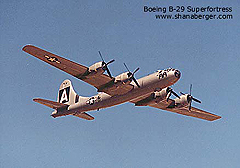|
||||
|
Boeing B-29 Superfortress
|
|
In order to meet the USAAC's 1940 requirements for a "superbomber", the Superfortress used a narrow chord, highly loaded wing, a pressurized cabin, and remotely controlled gun turrets. First flown on September 21 1942, B-29 Superfortresses were used to drop the two atomic bombs on Hiroshima and Nagasaki that ended World War II. After World War II, an improved B-29 went into service designated the B-50. The first post-war Russian bomber, the Tu-4 Bull, was a direct copy of the B-29. |
|||||||||||||||||||||
| Specifications |
Designations |
|||||||||||||||||||||
|
|
|
|||||||||||||||||||||
|
|
|||||||||||||||||||||
|
Related Pages |
||||||||||||||||||||||
|
|
|
|
||||||||||||||||||||||||||||||||||||||||||






